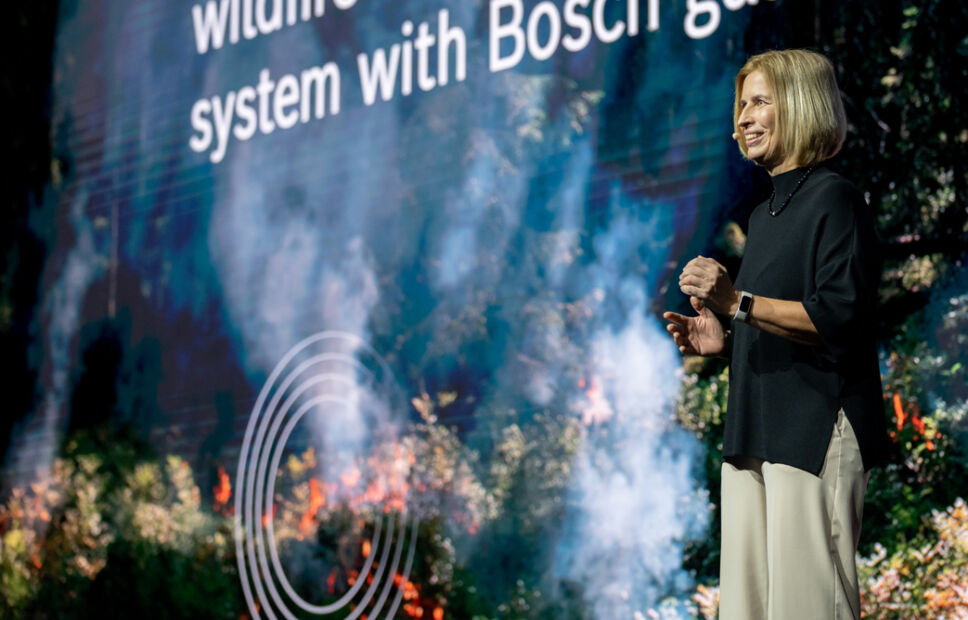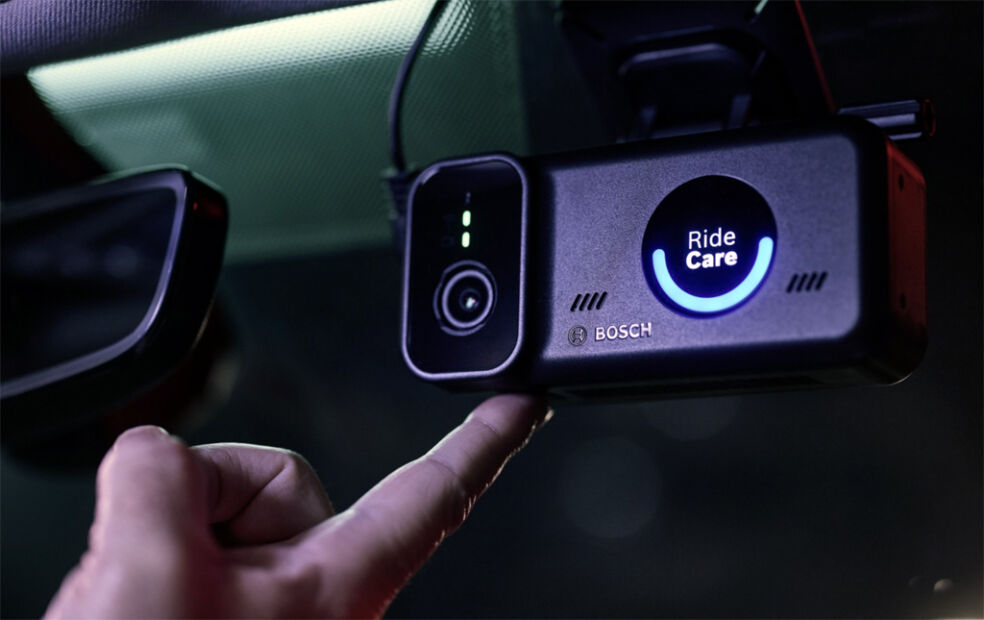Bosch focuses on sensors at CES
- January 11, 2023
- Steve Rogerson

Bosch focused on sensors at last week’s CES in Las Vegas with launches ranging from particle matter detectors to a digital fitness coach.
Sensors allow cars, e-bikes, smartphones, fitness trackers and headphones to sense their environment. Bosch is a pioneer r in microelectromechanical (MEMS) sensors – one of the most important and widely used sensor types today.
“We started production of MEMS sensors in 1995,” said Tanja Rückert, member of the board of management at Robert Bosch, at CES. “In the past five years, we have produced as many of these sensors as in all the years before that.”
Bosch has produced more than 18 billion MEMS sensors; today, there are an average of 22 of them in every car. By 2027, global annual demand for such sensors is expected to grow from 33.5 billion now to around 49 billion units.
To meet this growing demand, Bosch is investing in its wafer fabs in Dresden and Reutlingen. Overall, the company plans to invest €3bn in its semiconductor business, and thus also in sensor development and manufacturing, by 2026.
“With the help of sensors, we can take technology that is invented for life to a new level,” said Rückert. “They not only improve people’s quality of life but also reduce the environmental footprint of our smart everyday companions.”

At CES, Bosch presented several sensor-based innovations for mobility, including the RideCare companion, which won a Best of Innovation Award at the show. The RideCare companion can play a critical part in the enhancement of safety for all vehicle occupants in connected and automated mobility. The connected hardware and software consist of a camera, a wireless SOS button, and cloud-based data services.
Vehicle drivers can use it to contact Bosch associates around the clock should an accident or other dangerous situation occur. In the event of an incident, the Bosch associate can look into the vehicle via camera, assess the situation, and, if necessary, quickly request assistance.
Bosch announced the BMV080, said to be the world’s smallest PM2.5 air quality sensor that provides accurate, actionable data.
“Indoor air quality is a problem,” said Lucas Ginzinger, head of product area optics at Bosch Sensortec. “In poorly ventilated homes, PM2.5 concentration from domestic cooking can reach levels 100 times higher than acceptable limits. With localised, actionable data from the new BMV080, it’s now possible to identify and respond to poor air quality.”
The BMV080 sensing element measures 4.2 by 3.5 by 3mm, which is more than 450 times smaller in volume than any comparable device on the market. The fanless design makes it noiseless and maintenance-free with no fan-induced dust build-up, which means it is more reliable and less prone to malfunction. It is a fit for compact wearable or IoT devices such as air quality monitors, smart thermostats, smart speakers, smart switches and smart air purifiers.
“The BMV080 provides timely, accurate and actionable information about particulate concentration levels in the air, enabling the identification and handling of indoor and outdoor pollution to improve people’s well-being and health,” said Stefan Finkbeiner, CEO at Bosch Sensortec. “It is dramatically smaller than existing devices on the market and opens up an entirely new set of applications for design engineers to explore.”
The BHI360 is a programmable IMU-based sensor combining a gyroscope with an accelerometer that enables customisation. The integrated sensor fusion library enables 3D audio with head orientation for personalised sound experiences as well as simple gesture recognition.
A product variant, the BHI380 equips the sensor with additional algorithms. BHI380 is based on the same architecture but also includes self-learning AI software suitable for a wide variety of fitness tracking, thus making training and tracking easier and enabling personalised workouts. Dedicated swim tracking software measures swimming style and boosts users to the next fitness level in the water, while the pedestrian dead reckoning algorithm helps users reach their destination, even when the GPS signal drops out for a few minutes.
This means it is suitable for hearable and wearable devices. Typical applications include pedestrian navigation, 3D audio, personalised fitness tracking, and human-machine interaction.
“When we say that the BHI360 and 380 are the most intelligent programmable IMUs ever, we mean they have the most powerful built-in microprocessor, paired with an extensive software library of integrated algorithms,” said Finkbeiner.
The sensor is provided in a 20-pin LGA package measuring 2.5 by 3 by 0.95mm. Typical current consumption is less than 600µA for 3D orientation.
The BMP585 is a robust barometric pressure sensor that can be used underwater and in harsh environments, for example, in wearables for swimming. It includes a liquid-proof gel cover, which means it can be used in wearables that will be exposed to water or other liquids, including salt water and chlorinated water in swimming pools.
It includes all the features of Bosch’s existing BMP581 pressure sensor, with comparable accuracy, while providing the robustness needed for different use cases. Low power consumption ensures long battery life in wearables, hearables and portable applications.
“With the BMP585, OEMs don’t need to sacrifice performance to achieve robustness,” said Finkbeiner. “There’s no compromise necessary. With its extreme accuracy, the sensor measures a change in height of just a few centimetres. It can therefore detect movements in fitness training down to the level of individual pull-ups or push-ups. At the same time, users do not have to worry about environmental conditions thanks to its ruggedness.”
The device provides reliable mapping data for distance travelled and metres of altitude for hiking or running trips, thus supporting GPS data, and enabling accurate localisation and navigation.
It can also be used in industrial use cases such as liquid-level detection. Since its seal blocks access to dust, the sensor is suitable for clog detection in home appliances such as vacuum cleaners.
Relative accuracy is ±0.06hPa and typical absolute accuracy ±0.5hPa. Typical temperature coefficient offset is ±0.5Pa/K and RMS noise 0.08Pa at 1000hPa typical. Long-term drift over 12 months is ±0.2hPa. Typical current consumption is 1.3μA at 1Hz data rate.
The BMP585 comes in a nine-pin LGA package with a metal lid, measuring 3.25 by 3.25 by 1.86mm, and is small enough to use in smartwatches and other wearables.




